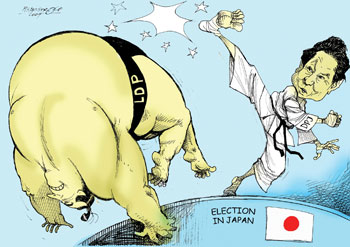
“Imagine a team of doctors who think more poison is the solution to poisoning.” That’s the attention-getting opening sentence leading off an invitation to attend a conference exploring the disaster known as the Obama administration. Good analogy! The team of experts currently running this nation has been administering its own type of poison to combat our nation’s economic downturn. Predictably, the recession isn’t ending. Instead, the nation wallows in a self-imposed and deepening quagmire.
If the Obama economic team (Geithner, Summers, and Volcker, along with recently re-anointed Fed Chairman Bernanke) really wanted to steer the United States out of the economic doldrums, they could learn from Japan’s experience over the past 17 years. The once-booming Asian nation saw its inflation-created bubble explode in 1992. Government program after government program has been tried to reverse Japan’s doldrums, but the nation is still stuck in its long-standing recession.
On August 30, Japan’s voters finally said they’d had enough of the ruling political party’s 55 years of almost uninterrupted domination. In a monumentally historic rout, voters awarded the Democratic Party of Japan (DPJ) 308 of the 480 seats in the Lower House. DPJ already has control of the Upper House via a coalition and is now assured of complete control. The victorious party’s leader, Yukio Hatoyama, will form a completely new government. Defeated Liberal Democratic Party (LDP) leader, Prime Minister Taro Aso, saw his Lower House representation shrink by almost two-thirds in the August 30 avalanche.
Viewers from afar surely wonder what happened. The answer is a combination of enormous debt and a procession of government programs that didn’t work, leading to failure to reverse serious economic stagnation. During the 17 years since Japan’s bubble burst, LDP political leaders had been insisting they had the answers to rising unemployment, the business slowdown, a rapidly aging population, and debt. They asked the people to give them more time to cure the nation’s woes. The people finally said no.
 Japan’s defeated leaders insist they tried everything. And they really did except for the one solution needed above all: get the government out of the way and let the people solve the problem. Japan’s central bank lowered interest rates, increased the money supply, and issued loans to businesses. The government created massive public works programs. There were bailouts for companies and banks, and some were nationalized. And on top of all of this, stimulus packages shoveled money at the people. But after 17 years of all of this governmental action, Japan’s long stagnation continues.
Japan’s defeated leaders insist they tried everything. And they really did except for the one solution needed above all: get the government out of the way and let the people solve the problem. Japan’s central bank lowered interest rates, increased the money supply, and issued loans to businesses. The government created massive public works programs. There were bailouts for companies and banks, and some were nationalized. And on top of all of this, stimulus packages shoveled money at the people. But after 17 years of all of this governmental action, Japan’s long stagnation continues.
It’s all there for anyone to see. Treasury Secretary Timothy Geithner could see it if he cared to look. So could the president’s Director of the National Economic Council Lawrence Summers and the Chairman of the Economic Recovery Board Paul Volcker. And we can be certain that Federal Reserve Chairman Ben Bernanke knows what happened in Japan. These key advisers to President Obama aren’t stupid and aren’t denied access to factual information.
Yet, look at what America’s experts have done in response to our nation’s recession. In every detail, they did exactly what Japan has been doing for 17 years. They cut interest rates, launched public works programs, handed out business loans and bailouts, and created stimulus packages, while the Fed manufactured trillions out of thin air. The result: our nation remains mired in our own slowdown. What happened in Japan is being repeated here.
Various economists and media luminaries tell us that the United States is now “rounding the corner,” “pulling out of the doldrums,” and “poised for a return to prosperity.” But the best news they can produce is that unemployment hasn’t risen as much as they predicted. We’re not supposed to note that jobs are still disappearing and the country as a whole is still suffering. Our nation’s only growth industry today is government itself.
In choosing an alternative to their long-serving political party, Japan’s voters have installed a possibly even worse choice. The DPJ wrongly blames free-market economics for Japan’s problems when true free-market policies have already been shunned. Attacking the government’s budget deficit by cutting waste, a DPJ claim, has been a minimally effective plan wherever it has been presented as a solution to indebtedness. The DPJ’s plans to subsidize farmers and cancel toll-taking on highways will be costly and costs will surely exceed whatever is saved by attacking waste. And the DPJ’s promise to deal with the declining birth rate by paying families $270 per month per child is hardly going to reduce government spending. Summing up: the Hatoyama government will no more spend Japan into prosperity than will the Obama government here in America.
America could learn from Japan’s woes. But there is no evidence that our current leaders have either the will or the desire to do the needed learning. Voters here must be made aware of the consequences of more government programs so that they don’t follow Japan’s lead by applying more poison when an already-applied dose has made the nation sicker.


